May 2
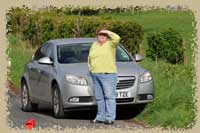 As usual, on vacation I'm up at dawn and raring to go. This is unusual, of course, since getting me out of bed before 8am on a regular day is just about impossible. That's me, a night owl of the first order. But on vacation? I'm showered and ready for breakfast by six and prodding the lazy husband to 'hurry up! We're on VACATION!' He, of course, is figuring - 'vacation! Relax, take is easy, sleep in…' Nope. Not on our vacations!
As usual, on vacation I'm up at dawn and raring to go. This is unusual, of course, since getting me out of bed before 8am on a regular day is just about impossible. That's me, a night owl of the first order. But on vacation? I'm showered and ready for breakfast by six and prodding the lazy husband to 'hurry up! We're on VACATION!' He, of course, is figuring - 'vacation! Relax, take is easy, sleep in…' Nope. Not on our vacations!
The bathroom in our room has an enormous tub and is heated to 'toasty' by a huge towel-warmer-radiator on the wall. The room was rather chilly, so walking into the blissfully warm bathroom was very nice. "Towel warmers" are commonplace here - either as a separate appliance to just warm the towels, or as the primary heat source in a bathroom without central heat. I love radiator-heated towels. I wish I had one in my own bathroom - there's nothing like a hot, scratchy towel from the radiator, almost crispy it's so hot. They're even better than towels hot from the dryer (another sensual pleasure, ranking right up there with standing over the heat vents on a cold morning). One of my favorite memories as a child was taking a bath at my grandmother's house : she had those huge old steam-radiators that hissed and burbled. The tiny bathroom had one of the largest radiators in the house, and towels draped over it were almost singed. Getting out of the bathtub and wrapping myself up in a big hot towel..mmmmmm. Along with that memory, of course, is the memory of having parallel burns on my butt from leaning backwards into the hot radiator once or twice. But, it was worth it!
The Full Scottish
Breakfast at Traquair house is served in the Stillroom - traditionally a small pantry or storeroom connected with the kitchen used for preparing tea and beverages and for storing liquors and preserves and teas. Because the house only has a few rooms to let, there are few guests, and the cozy room has been fitted out with two tables for serving meals. The cabinets around the room contain antique china and glassware, and (like everywhere else in the house) there are portraits of the family. The young man in the stillroom portrait is just about the least dour and stern of all them and he still looks positively dyspeptic.
The "full scottish breakfast" is a filling meal - at least for the tourists, I can't imagine that everyone actually eats like this every day!. Eggs, bacon, sausage, haggis, mushrooms, tomato, potato scone, clootie dumpling, fruit, cereal, porridge, toast, yogurt. We went for the Full Scottish this morning (you have to try it at least once) and very nearly had to go back to bed to rest a while to recover. Try the haggis (really, it's just sausage, people) and throw your diet out the window. Me? I'm a bacon fiend when I'm anywhere in the UK. Love, love, love the bacon there.
We met two other guests at breakfast - an English couple who were hill-walking in Scotland for a week or so. Their plan was to walk to Melrose Abbey (about 17 miles or so) and follow the River Tweed for the rest of the week. We had a good laugh that we were going to drive to Melrose today, and that was enough for us. The woman was still recovering from major knee and ankle surgery, and this is "training" for even longer walks later in the year. We might hike off into the fields for a few miles or so, but planning on twenty-mile hikes every day is a little too much for me!
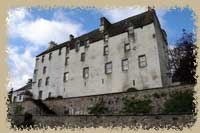 We had the opportunity to walk through Traquair House before it was opened for the day, by ourselves. That was a novelty. The house has at its core a ()th century tower house, which has been raised a few stories, had wings added, and eventually made into a comfortable country house. The oldest part of the house (the tower) has ten foot-thick walls and tiny windows, and the rooms there have some examples of original painted ceilings, wall murals, and a collection of family documents and artifacts - mirrors, snuff boxes, weapons, lock-boxes, bibles, the works. The floor in one room sags alarmingly (the foot-square beams have sunk at least 10" and the curve is so pronounced that it almost looks like a hammock.
We had the opportunity to walk through Traquair House before it was opened for the day, by ourselves. That was a novelty. The house has at its core a ()th century tower house, which has been raised a few stories, had wings added, and eventually made into a comfortable country house. The oldest part of the house (the tower) has ten foot-thick walls and tiny windows, and the rooms there have some examples of original painted ceilings, wall murals, and a collection of family documents and artifacts - mirrors, snuff boxes, weapons, lock-boxes, bibles, the works. The floor in one room sags alarmingly (the foot-square beams have sunk at least 10" and the curve is so pronounced that it almost looks like a hammock.
Historic Scotland and The National Trust
When we were in Scotland in 1999 (was it really ten years ago? Wow), on our list of 'must sees' include the Border Abbeys - Melrose, Jedburgh, Dryburgh, Kelso. One of my favorites was Melrose Abbey, a romantic, sprawling ruin beloved by Sir Walter Scott, and I wanted to see it again on this trip. Since we're staying in the Borders for a couple of days, we decided to make the ring around the abbeys our first day's trip. Probably biting off a bit too much, but they are do-able in a single day if you get an early start. And of course, if you aren't distracted by the absolutely stunning scenery in the southern part of Scotland. It's hard not to just stop and gawk sometimes.
It's at this point that I should shamelessly plug for Historic Scotland. Many of the historic sites in Scotland are under the care of the state and aegis of Historic Scotland -- getting a membership is absolutely worth it if you are going to visit more than a few of the major sites (Edinburgh castle, Stirling Castle, the abbeys, etc). Entrance fees at most of these places range from a few pounds to up to twelve pounds for an adult. Historic Scotland offers a limited Explorer pass at nearly every site, for three days or seven days, and offering free entry to the major sites. The pass is good for any three days in a week, or any seven days in a 14 day period. The price is £21 or £30 for adults. Given the cost, it's worth a yearly membership for £69 for two adults, which can be used every single day of your trip. And, of course, you're supporting the costly and difficult job of maintaining these sites. The National Trust is another entity that maintains historic sties (they tend more towards the museums and restored mansions) - it is worth looking into their membership as well, if you like that sort of thing. You can purchase a membership (either limited or annual) at any manned site. Plan ahead, though, and you'll have actual membership cards to flash, instead of paper receipts.
Border Abbeys and more
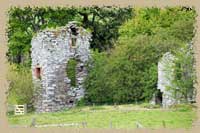 Melrose is a massive ruin, it's well worth getting the audio tour of the site - it's well done and very interesting (and free if you're a member). This time we found the downspout that is a pig playing a bagpipe -- climb up the remaining tower to the roof, the pig is on the lower church roof and you can lean out for a pretty cool picture. We walked across the missing cloister and through the modern gate to the Commendator's house -- originally the whole site would have been inside the main wall; the modern road cuts across the drainage sewer. There are the foundations of other buildings near the house (which houses a museum full of bits and pieces from the abbey), but only faint remains can be seen. Watch you don't pitch headfirst into the medieval drains, though - they are open, and deep! Being fascinated as I am about medieval toilets, the sewer system - a diversion from the river that provided sanitary facilities in the monastery, is pretty interesting to me. YMMV, of course.
Melrose is a massive ruin, it's well worth getting the audio tour of the site - it's well done and very interesting (and free if you're a member). This time we found the downspout that is a pig playing a bagpipe -- climb up the remaining tower to the roof, the pig is on the lower church roof and you can lean out for a pretty cool picture. We walked across the missing cloister and through the modern gate to the Commendator's house -- originally the whole site would have been inside the main wall; the modern road cuts across the drainage sewer. There are the foundations of other buildings near the house (which houses a museum full of bits and pieces from the abbey), but only faint remains can be seen. Watch you don't pitch headfirst into the medieval drains, though - they are open, and deep! Being fascinated as I am about medieval toilets, the sewer system - a diversion from the river that provided sanitary facilities in the monastery, is pretty interesting to me. YMMV, of course.
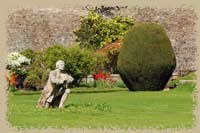 The day is gorgeous - sunny and blue-skied and absolutely perfect. A bit windy, but we'll come to expect that after a few days. We had passed the signs for Abbotsford, home of Sir Walter Scott, on the way to Melrose and decided to stop by quickly on our way back past it. Many of the architectural details of the house were copied (or sometimes taken, I am led to believe) from the ruins of Melrose Abbey. The house itself is a fanciful collection of towers and chimney pots - the original small manse has been extended by various owners over the years. The original part of the house is open to visitors - the library, the armory room, a few shrines to the great man himself. Of course, we visited when they were in the middle of shooting a movie in the house so it was completely rearranged and the crew had taken over the main rooms and redecorated them in modern glass-and-steel furniture. It was rather shocking, and the docent was quite put out about the re-arrangement and the fact that all the original, antique furniture was stacked willy-nilly in the dining room, and was thus inaccessible to visitors.
The day is gorgeous - sunny and blue-skied and absolutely perfect. A bit windy, but we'll come to expect that after a few days. We had passed the signs for Abbotsford, home of Sir Walter Scott, on the way to Melrose and decided to stop by quickly on our way back past it. Many of the architectural details of the house were copied (or sometimes taken, I am led to believe) from the ruins of Melrose Abbey. The house itself is a fanciful collection of towers and chimney pots - the original small manse has been extended by various owners over the years. The original part of the house is open to visitors - the library, the armory room, a few shrines to the great man himself. Of course, we visited when they were in the middle of shooting a movie in the house so it was completely rearranged and the crew had taken over the main rooms and redecorated them in modern glass-and-steel furniture. It was rather shocking, and the docent was quite put out about the re-arrangement and the fact that all the original, antique furniture was stacked willy-nilly in the dining room, and was thus inaccessible to visitors.
The best part, though? They had sprayed fake snow all over the courtyard, so it looked as if a late-spring snowstorm had rolled in and blanketed the formal gardens and great stone portico with a couple inches of the white stuff. The crew was busily vacuuming it back up, now that hey were done, but we can now at least claim that we have seen snow in Scotland. Even if it was fake.
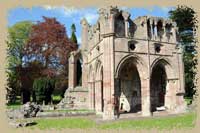 Off to Dryburgh Abbey, which is one of the most peaceful ruins that I can remember. Much less remains here than at Melrose (than at just about any abbey we visited, actually), but the site has graceful trees, lovely green lawns, and hundreds of birds. The cream-colored stone of the abbey seems almost jewel-like in the greenery. The cloister and monastery buildings are arrayed much lower than the ruins of the church, though. It's common for the cloister walk to be down a few steps but the drop off here was impressive - windows in the church aisle would have been over the top of whatever roofing the cloister had, the difference had to be ten feet or more. Outside of the church buildings and the connected monastery buildings, no other foundations exist except a huge gatehouse leading to the site itself.
Off to Dryburgh Abbey, which is one of the most peaceful ruins that I can remember. Much less remains here than at Melrose (than at just about any abbey we visited, actually), but the site has graceful trees, lovely green lawns, and hundreds of birds. The cream-colored stone of the abbey seems almost jewel-like in the greenery. The cloister and monastery buildings are arrayed much lower than the ruins of the church, though. It's common for the cloister walk to be down a few steps but the drop off here was impressive - windows in the church aisle would have been over the top of whatever roofing the cloister had, the difference had to be ten feet or more. Outside of the church buildings and the connected monastery buildings, no other foundations exist except a huge gatehouse leading to the site itself.
We set the GPS to find Jedburgh and were almost instantly distracted by one of the brick bridges across the River Tweed, and executed a rather hair-raising set of u-turns and lane-crossings on the main road to get to the bottom of the ramp and take a look. At first glance, we thought it was an aqueduct - it certainly looked like a roman design. Alas, it was only a 19th century, multi-arched railroad bridge, abandoned in 1964.. However, a short walk up the hill brought us to a viewpoint over the roman town of 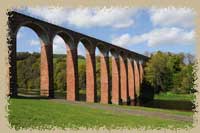 Trimontium and the nearby arena and amphitheater. It's very hard to see anything from ground level - even climbing the little wooden tower doesn't really give a clear view of the site, even though the maps insist that you can see the city walls and evidence of towers in the plowed field. On the other side of the road, the round depression of the amphitheater is easy to see, and the ruined foundations of a roman bridge. The main roman road (Dere Street) runs through the site and along the river. It takes a bit of imagination to see things. We traipsed along the riverbank for awhile, met a tattooed couple from Glasgow walking a teensy little dog, and sat with another couple out walking along the river.
Trimontium and the nearby arena and amphitheater. It's very hard to see anything from ground level - even climbing the little wooden tower doesn't really give a clear view of the site, even though the maps insist that you can see the city walls and evidence of towers in the plowed field. On the other side of the road, the round depression of the amphitheater is easy to see, and the ruined foundations of a roman bridge. The main roman road (Dere Street) runs through the site and along the river. It takes a bit of imagination to see things. We traipsed along the riverbank for awhile, met a tattooed couple from Glasgow walking a teensy little dog, and sat with another couple out walking along the river.
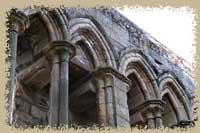 It was getting late (everything closes by 5 or so, getting an early start is important!) and so we drove straight into Jedburgh to see the magnificent abbey ruin there. We arrived just barely in time to get in, and spent a half-hour completely alone in the abbey church. The abbey here is built on a rocky hill that overlooks the town, all the buildings associated with the abbey are built into the hillside and are mostly unrecognizable. Ongoing excavations keep finding more and more of the original buildings and footings. This is one of the few abbeys where I can't quite "see" the complex, although the church itself is remarkably well preserved, with all three rows of window arches still extant. It's worth a climb up into the tall end tower to look down the aisle of this enormous church.
It was getting late (everything closes by 5 or so, getting an early start is important!) and so we drove straight into Jedburgh to see the magnificent abbey ruin there. We arrived just barely in time to get in, and spent a half-hour completely alone in the abbey church. The abbey here is built on a rocky hill that overlooks the town, all the buildings associated with the abbey are built into the hillside and are mostly unrecognizable. Ongoing excavations keep finding more and more of the original buildings and footings. This is one of the few abbeys where I can't quite "see" the complex, although the church itself is remarkably well preserved, with all three rows of window arches still extant. It's worth a climb up into the tall end tower to look down the aisle of this enormous church.
Rounding out the quartet is Kelso - which has the scantest remains of all, but was once probably the largest abbey in the borders. Only a tiny fragment of the church wall remains standing (barely - you can see the ominous bulge of the walls, held in place with great metal braces and screws). Someone has added a modern crypt to the grounds, and you can also follow what look like railroad tracks in the middle of the tower. The grounds have been reduced to a few feet beyond the walls, and the walls of the church lie up against the main road in Kelso in the front and a school building in the back. It might actually be easy to miss if you didn't know it was supposed to be there.
Let me explain "the dots"
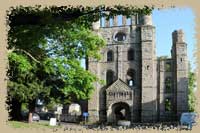 I know the Border Abbeys are part of the standard tourist route (actually, Kelso is usually left off the list), but they are definitely worth visiting. Our dinner reservations aren't until eight, so we still had a couple of hours to wander around (and find our way back to Traquair!) so we set off into the world trying find one of the dots on the map. If you've read any of the other travelogues I've done, "The Dots" will be very familiar -- I love castle ruins, the crumblier the better, so I go through the reference books and mark them all with dots on the map (about 3000 of them), which we spend far too much time trying to track down.
I know the Border Abbeys are part of the standard tourist route (actually, Kelso is usually left off the list), but they are definitely worth visiting. Our dinner reservations aren't until eight, so we still had a couple of hours to wander around (and find our way back to Traquair!) so we set off into the world trying find one of the dots on the map. If you've read any of the other travelogues I've done, "The Dots" will be very familiar -- I love castle ruins, the crumblier the better, so I go through the reference books and mark them all with dots on the map (about 3000 of them), which we spend far too much time trying to track down.
We had two dot-misses today - one near Trimontium - when I finally checked the reference book, it noted that there were 'no visible remains" of the castle (ok, why on earth did I put a dot on the map when there wasn't anything there? I have no idea) and the second one today where we couldn't’t seem to get to the road where the dot should have been. But the second miss ended with a rather interesting adventure - signs noting "weak bridge" routed us to a cast iron bridge (I think) that was barely wide enough to get the car through and warned us a dozen times or more that the speed limit was 5 and the weight limit was less than 5000 pounds. We stopped to take pictures. It was an attractive bridge, actually, and the first of many "weak bridges' we saw while driving around. I imagine that the signs are a bit of CYA by the road management people to keep from getting sued when someone drives an enormous lorry over these old, often rickety, bridges.
Homecoming Dinner
At this point, Mark was starving and we needed to get back to Traquair for dinner. We had booked their Homecoming special, which was two nights B&B and one dinner with their special "Scottish menu" -- traditional Scottish dishes with a modern flair. Helen, our ever-present housekeeper, was hostess, waitress, and may have been cook, for all I know! We were the only ones having dinner at the house, and we have the stillroom to ourselves, a lovely bottle of wine, and candles and white tablecloth. I had chicken stuff with haggis in a sherry sauce, Mark had cock-a-leekie soup and salmon and we both ate cranachan for dessert. That's a concoction of toasted oats and slightly-sweetened cream and it quite tasty. It's not a sweet dessert (in fact, it was probably the least sweet dessert we had while in Scotland!).
We crashed like big crashy things in the too-short bed (note to self: try to pick hotels where the beds do not have footboards when you have a very tall husband). I don't remember anything after dinner except staggering to the room.
.

